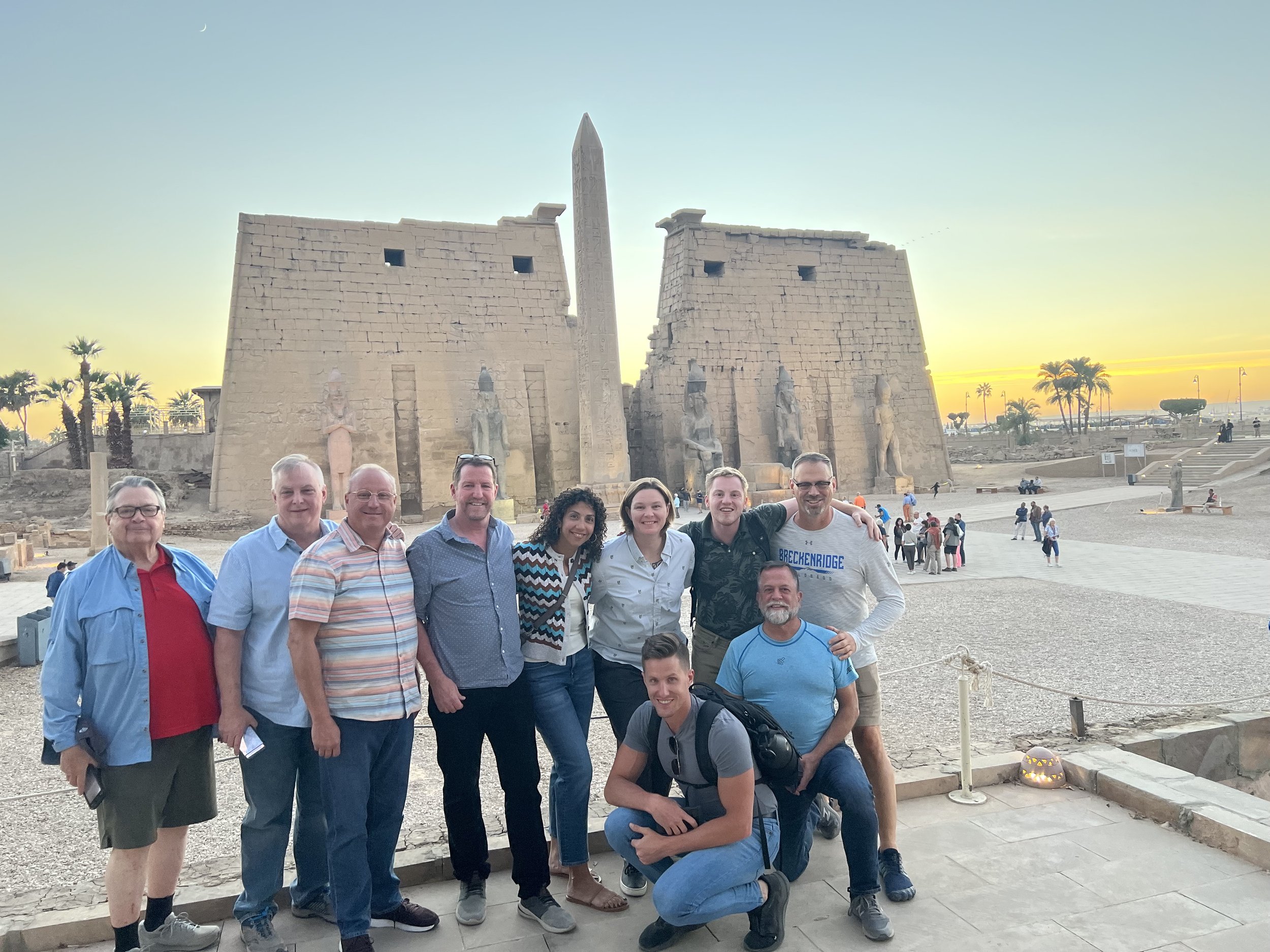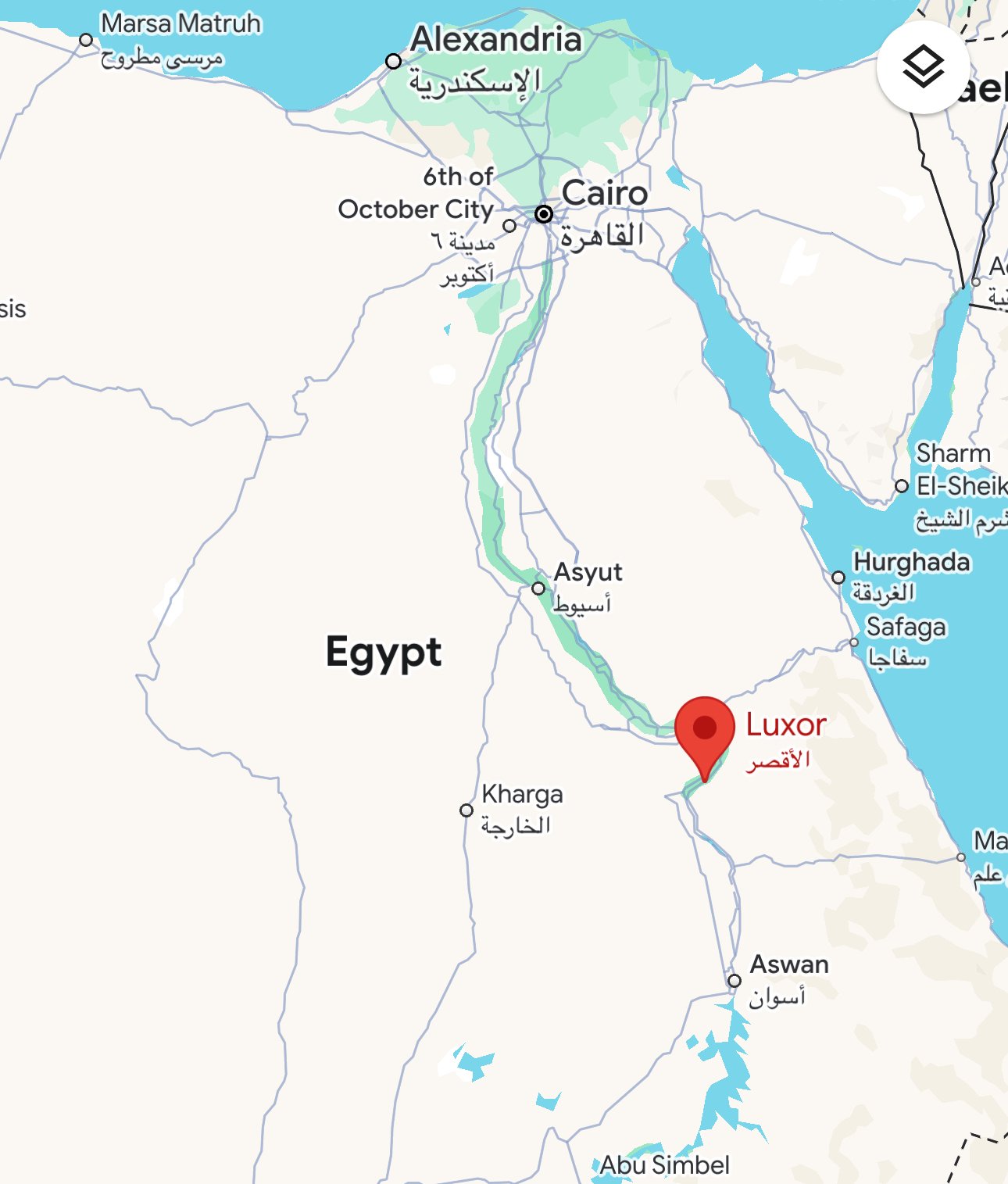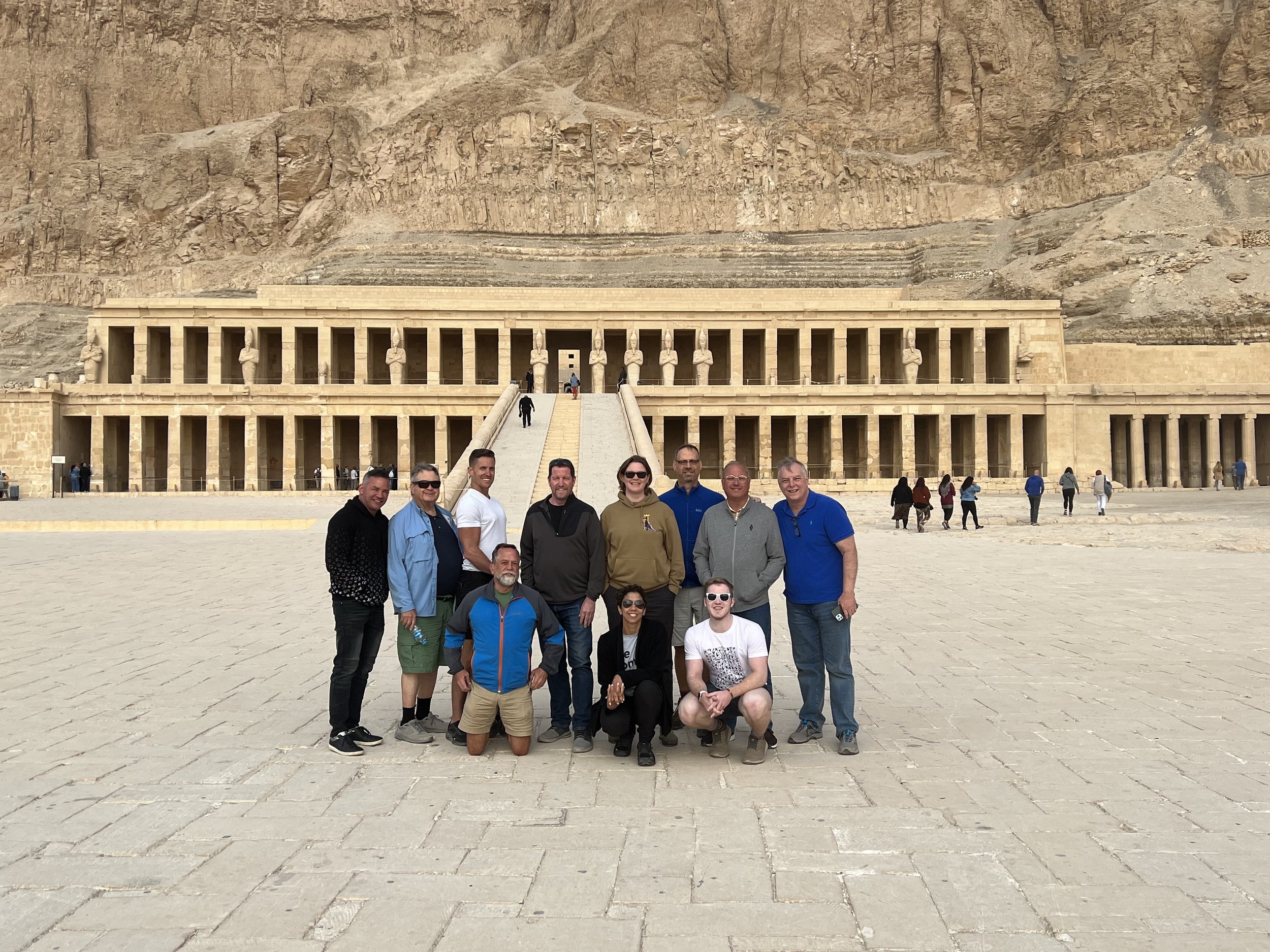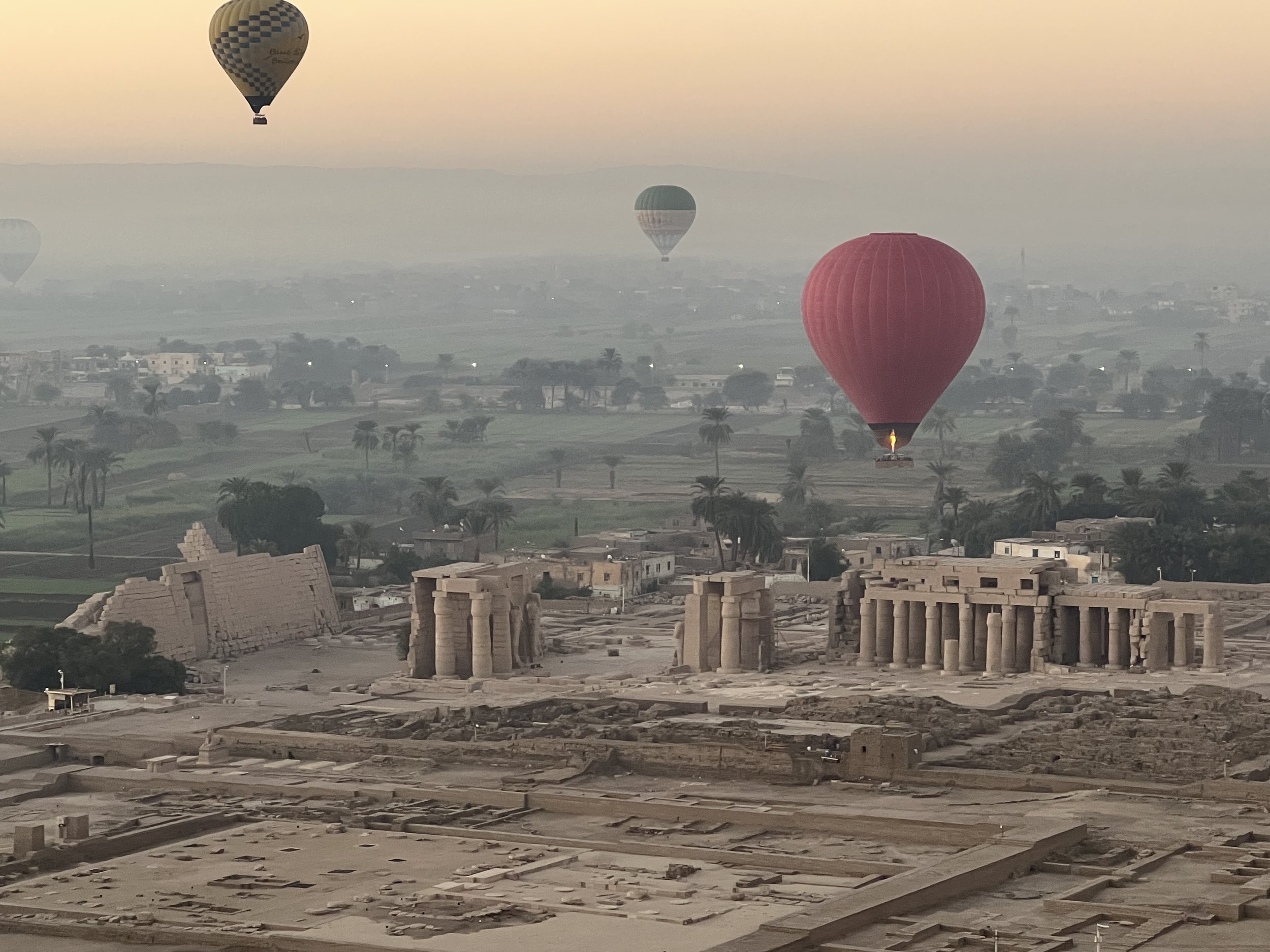Things to See in Luxor Egypt
Sunset at Luxor Temple!
Luxor is the second-most important place to visit in Egypt aside from the Giza Pyramids and the Sphinx. Places like Karnak Temple, the Valley of the Kings, Hatshepsut's Temple, the tomb of King Tut, and doing a sunrise hot air balloon over the Nile River are just a few of the experiences this city in Upper Egypt has to offer during your trip. Let's talk about the must see attractions in Luxor, the best Luxor Restaurants, best hotels in Luxor, and answer all your frequently asked questions before your Luxor trip.
General information about Luxor
Luxor, Egypt is located in the south of the country, around 400 miles south from Cairo (8 hour drive or train ride), and around 150 miles north of Aswan (4 hour drive or train ride). The city sits directly on the Nile River, and when talking about Luxor, we often use the terms east bank and west bank to refer to which side of the Nile River we are on. In general, the East Bank of Luxor has the most hotels and restaurants, and also has a couple sightseeing attractions, whereas Luxor's West Bank is more quiet and agricultural, with fewer hotels and restaurants, but a lot of sightseeing stops.
Luxor, Egypt is around 8 hours south of Cairo by car or train, or about 4 hours north from Aswan.
What does Luxor mean?
The word "Luxor" derives form the Arabic word that means "Palaces" - when Arabs came to Egypt and noticed all the ancient Egyptian Temples in Luxor, they thought these were giant palaces of the ancient Egyptians, and so they gave Luxor it's name - the city of palaces.
Should I book a private tour in Luxor?
Luxor has dozens of ancient sites, spread out over both banks of the Nile River, and all the logistics of setting up a tour means that it's very helpful to have a local Egyptian guide with you to help create the best experience, avoid hassles from overzealous local vendors, and also explain the hundreds of historical artifacts you will see.
Luxor Egypt must see attractions
There are four attractions that must not be missed if you visit Luxor, Egypt, however, you can easily spend an entire week in Luxor and not take in all the ancient treasures the city has to offer! If you have a quick trip, here are the most important things to see in Luxor in one day (or two relaxed days):
The Valley of the Kings
The Valley of the Kings has astonishingly clear reliefs and colors in several tombs!
The Valley of the Kings is the second most important ancient site to visit besides the Giza Pyramids and Sphinx, and is my top choice for what to see in Luxor. The tombs of the pharaohs from Egypt's New Kingdom period are astonishingly well-preserved, with many tombs still containing the original colors on the wall reliefs. Seeing the tombs of great pharaohs like Ramesses III, Merenptah, and Seti I is awe-inspiring.
You can buy tickets online in advance for the Valley of the Kings here, or you can purchase them in person with a Visa or Mastercard.
Note that tour guides are unfortunately not allowed inside the tombs at the Valley of the Kings (imagine if all those tour guides were trying to brieif their guests inside the tombs, with the noise overwhelming the experience of seeing the tombs themselves), so your guide will give you the briefings outside the tombs, and then if you have any questions about what you see inside the tomb, snap a picture with your phone, and show it to your guide when you exit!
Should I visit the tomb of King Tut?
The Pharoah Tutankhamun (King Tut) did not rule Egypt for long, but when his tomb was discovered in the Valley of the Kings over 100 years ago, it sparked a renewed worldwide interest in ancient Egypt, since the tombs was fully intact, with over one thousand artifacts and hundreds of pounds of gold. To me, the tomb of King Tut is a must-see for anyone at the Valley of the Kings, because even though the tomb is very small, it is the only tomb to still contain its mummy (the mummified remains of King Tut rest in thside the tomb and can be viewed through glass), the wall paintintgs that remain are in amazing condition, and this tomb was such an important discovery, forever changing the field of Egyptology.
Extra tombs at the Valley of the Kings
In addition to King Tut's tomb, I think the Tombs of Ramses V and VI are great to visit (since these tombs are not very expensive, and are beuatifully decorated), and the tomb of Seti I is a good option for those who are ready for tons of stairs and want a tomb that is almost empty (see my YouTube video for more information). I do not recommend visiting the tomb of Ay, since it is not very well preserved and is far away from the other tombs. However, there are almost never any tourists inside!
Best tombs at the Valley of the Kings
When I am taking tour groups. to the Valley of the Kings, here are the tombs I usually have us visit (depending on the lines and waits). Your ticket to the Valley of the Kings gets you access to three tombs, not counting the special tombs (King Tut, Seti I, Ramses V/VI, and Ay)
- Ramesses III: the tomb of Ramesses III has amazing colors and beautiful reliefs. It can also be one of the busiest tombs, though!
- Tausret and Setnakht: I like seeing the tomb of Tausret and Setnakht, since this tomb is a bit further into the valley, and so the crowds are minimal. The tomb also has nice colors and reliefs that remain.
- Ramses I: Ramses I's tomb has the most treacherous steps in all of the tombs (they are seriously steep!) but the deep blue color and the paintings showing Ramses I at the tomb's bottom chamber make it worthwhile!
- Merenptah: the tomb of Merenptah is one of the largest in the valley with tons of stairs, but the bottom burial chamber with its massive granite sarcophagus make it one of my favorites
- Extra tombs: out of the extra tombs at the Valley of the Kings, I always recommend King Tut and Ramses V and Ramses VI, and Seti I (depending if the guests want to pay the higher ticket price and are ready for hundreds of steps!)
Karnak Temple
The quality and color of the reliefs at the Khonsu Temple make it a must visit area of the Karnak Temple complex!
Second to the Valley of the Kings is Karnak Temple, the largest temple of ancient Egypt, and one of the largest temple complexes in the world! The massive columns of Karnak's Hypostyle Hall make the visit worth it by themselves - these columns are the largest in all of Egypt, and recent restoration work has reveleaed beautiful original colors under layers of dust.
Karnak also is the home to two giant obelisks (one by Hatshepsut, and the other started by Tuthmosis III and later finished by his grandson), and the Khonsu Temple to the side of the Hypostyle Hall is a must-visit, since almost none of the large tour groups go there, and the colors remaining are immaculate.
You can buy tickets online in advance for Karnak Temple here, or you can purchase them in person with a Visa or Mastercard.
The Mortuary Temple of Queen Hatshepsut (El Deir El Bahari)
One of my tour groups in front of the facade of Queen Hatshepsut’s Temple
Hatshepsut's Mortruary Temple (also called El Deir El Bahari in Arabic) is my third choice for must-see sites in Luxor. Hatshepsut was Egypt's most powerful female ruler, and her temple's unique design and reliefs make it an important site to visit. Since Hatshepsut's Temple is on the West Bank, close to the Valley of the Kings, it's a great idea to combine both visits, seeing one after the other.
You can buy tickets online in advance for Hatshepsut's Temple here, or you can purchase them in person with a Visa or Mastercard.
Colossi of Memnon
These gigantic statues of Amenhotep III are a must-see not because they are the most amazing statues in all of Luxor, but because the site is free to visit and also takes just a few minutes. This is also a great opportunity to see archaeology in action - the area is an active excavation, where Egyptologists are unearthing other statues and pieces of the ancient mortuary temple and reconstructing the temple, piece by piece. On a one day tour, seeing the colossi after visiting Karnak, the Valley of the Kings, and Hatshepsut's Temple is a great final photo-op stop.
Hot Air Balloon Ride
A sunrise hot air balloon over Luxor’s West Bank is a must!
For one of the most unique things to do in Luxor Egypt, experience a sunrise hot air balloon ride over Luxor's West Bank, taking in several ancient monuments from up high, and then see the sun come up over the Nile River Valley. It's an unforgettable experience, and one I recommend to all my guests. The hot air balloon rides are usually around $100 - $120 USD per person - if you are interested in booking a hot air balloon, send me an email (gus@egyptadventurestravel.com) and I can get you connected with the most reputable and safe balloon operators.
Best Luxor Hotels
Luxor has dozens of large, international hotel chains, and also hundreds of small, boutique hotels. Here are my top choices:
Hilton Luxor
The Hilton Luxor has the most beautiful view of the Nile River out of any of the hotels in Luxor, and the swimming pool is my favorite as well. The only downside to this hotel is that it is not walkable from many restaurants and attractions, but this also makes it a bit quieter.
Sofitel Winter Palace
The Sofitel Winter Palace used to be the most luxurious hotel in all of Luxor, and this historic property has seen guests like Princess Diana over its 100+ year history. I feel like the hotel could use a renovation overall, but the rooms are still very nice and you can't beat the historic nature of the property.
Djorff Palace Luxor
The Djorff Palace is a more budget-friendly hotel that is still on the caliber of the international hotel chains, and its location on Luxor's West Bank means it is quieter than the hotels on the hustle and bustle (and hassle) of the East Bank. Their restuarant serves a new menu each day for delicious lunches and dinners, and they provide a free boat service to bring passengers back and forth from the East Bank, so you can stay here and still go to the East Bank for dining and shopping. A major difference betweeh Djorff Palace and other large hotels is that the breakfast at this boutique hotel is classic Egyptian style, so they do not have all. the options of the international hotel breafkast buffets
Al Moudira Hotel
The nicest luxury boutique hotel in Luxor, the Al Moudira is unparalleld for its rooms, service, food, and ambiance. However, this hotel's isolated location on the West Bank make it impossible to walk to any restaurants, nightlife, or shops, but with the tranquil atmosphere of this luxury property, who would want to leave?!
Steigenberger Nile Palace or Steigenberger Achti Resort
The Steigenberger Brand has two properties in Luxor, the Nile Palace or the Achti. Both are great options for large hotels on the East Bank that are usually a bit more affordable than the Hilton or Winter Palace.
Budget Luxor Hotels
There are always new hotels on the budget scene in Luxor, but here are a few I have stayed at that I can recommend:
Amon Hotel Luxor
Breakfast in the gorgeous gardens of the Amon Hotel
The Amon Hotel is a family-run hotel on Luxor's West Bank, with an amazing garden full of gorgeous plants (the perfect setting for their included breakfast or to have lunch or dinner) and the friendly service make this my top budget choice.
Gezira Garden Hotel
Gezira Garden Hotel is a great budget option on Luxor's West Bank that also has a rooftop restaurant.
Best Luxor Restaurants
After a full day of touring in Luxor, travelers will need a great spot to rest and enjoy a large meal! Here are my favorite restaurants in Luxor:
Marsam Hotel
Enjoying lunch at the Marsam Hotel on Luxor’s West Bank
The Marsam Hotel is a guesthouse that has a courtyard restaurant, my favorite in Luxor. They serve a menu that changes daily, with a chicken, beef, fish, and vegetarian entree, and tons of delicious side dishes and salads. This spot is perfect after touring on Luxor's West Bank, but I don't recommend it in June, July, or August, since the restaurant is outdoors and even though it's shaded, there is not air conditioning.
Sofra
Sofra is a farm-to-table restaurant on Luxor's East Bank, close to the train station, and they give the best dining experience in Luxor outside of the Marsam or the major hotels. I love Sofra's commitment to featuring classic Egyptian dishes in an environment that is easy for tourists to enjoy, and everything they serve comes for their local farm on Luxor's West Bank.
Aside from my top two choices, here are other great options:
El Hussein Restaurant
El Hussein is a classic Egyptian restaurant, serving all the staples, and it's my top recommendation for guests at the Hilton Hotel, since it's right next door.
The Lantern Room
The Lantern Room is run by a British-Egyptian couple, and they have a mixture of Egyptian and British classics, so this place is perfect for when you want a break from Egyptian food, and want a fish and chips or a shepherd's pie!
Flafel (street food spot)
This tiny fuul and falafel joint (Egyptian street food) is across the street from Luxor Temple, so if you want a falafel sandwich and are on a budget, this is your spot!
Wolf Restaurant
Wolf Restaurant is on Luxor's West Bank, and it's the restaurant of choice for many archaeologists who spend lots of time in Luxor.
Restaurant and Cafe Maratonga
Maratonga has been around for decades, and is right across from Madinet Habu Temple, making it the perfect stop either before or after touring the mortuary temple of Ramses III.
Gerda's Garden
Gerda’s Garden is a local restuarant serves Egyptian and also German food, because the restaurant's owner and head chef spent time in Germany and developed a love for the local cuisine.
Unique things to see in Luxor
Aside from Karnak Temple, the Valley of the Kings, Hatshepsut's Temple, and the Colossi of Memnon, here are the other Luxor places to visit, in order based on how important I think each place is to visit:
Luxor Temple
Luxor Temple has amazing colossal statues of Ramses the Great
Luxor Temple is best to see at night, when the temple is lit up majestically by tons of floodlights. The statues of Ramses the Great that flank the temple's entrance and the first courtyard are my favorite statues in Luxor, and the avenue of the Sphinxes out in front of the temple makes a great spot for unforgettable photos with the obelisk and temple's main gate in the background.
Madinet Habu Temple
Madinet Habu is a beautiful temple, seldom visited by tourists!
This mortuary temple of Ramesses III is seldom visited by large tour groups, and it's amazingly well-preserved. It also has the most interesting reliefs of any of the other temples in Luxor, so it's one of my top Luxor Egypt attractions.
Deir el Medina Workers' Tombs
These tombs for workers are tiny, but even more amazingly decorated than some of the tombs in the Valley of the Kings! Plus, the fact that these tombs are seldom visited by other toursits makes this a great place to experience.
Tombs of the Nobles
Luxor's Nobles' Tombs are a great addition to the Valley of the Kings and Deir El Medina. The well-preserved tombs are also seldom visited by tour groups, making this site even more appealing.
Luxor Museum
Luxor Museum houses dozens of masterwork pieces of Egyptian statuary (they took the best preserved statues found in Luxor and house them in the Museum), and it's very well laid out and labeled, making it perfect for a self-guided tour. For those looking for what to do in Luxor that is not a tomb or temple, but still historical, this is it!
Valley of the Queens
At the moment, Nefertari's Tomb is closed indefinitely, so I don't recommend the Valley of the Queens, except for travelers who have lots of time in Luxor and would like to see tombs for princes (showing interesting depictions of royal children, who died and had tombs created showing them as young children, with interseting hair styles and dress).
Temple of Seti I
This temple is not as grandiose as Madient Habu, Karnk, or Luxor Temple, but it is rarely visited by tourists, giving you the place to yourself.
Ramesseum
The mortuary temple of Ramses the Great is very dilapidated, but it's still great to see the temple for one of Egypt's most important and powerful pharaohs.
These other places to visit in Luxor are not my top recommendations, but if you have a special interest in one particular site, or have 4+ days in Luxor, checking them out would be a great idea:
Howard Carter House
This house is where Howard Carter stayed when he was seraching for King Tut's Tomb. The house shows an interesting glimpse into the life of one of the most famous Egyptologists, and features a life-sized replica of King Tut's Tomb onsite.
Mummification Museum
A tiny museum (the size of a large classroom) that goes over the process of mummification, and features some ancient tools that were used to mummify animal and human remains.
Deir el Shelwit
A small temple that is a couple kilometers past Madinet Habu Temple. While this site is not very impressive, it is seldom visited by tourists.
El Assasif Tombs
Nobles tombs that are close to Hatshepsut's Mortuary Temple - the Deir el Medina Tombs or the other Nobles' Tombs are better to see, but El Assasif is good for those who want to see all the sites that Luxor has to offer.
El Tod Temple
This small temple is a half hour drive south from Luxor City, and like Deir el Shelwit, is only worth the visit if you want to have a temple all to yourself, as it is hardly ever visited.
How to Get to Luxor
Most travelers will visit Luxor after being in one of these cities: Cairo, Hurghada, or Aswan:
Cairo to Luxor Flight
Flying is the best way to get to Luxor from Cairo, since the 8+ hour drive or train ride is much less comfortable than the quick 1-hour flight, and flights can also be very affordable, with prices sometimes as low as $50 - $75 USD one way. EgyptAir, Nile Air, and Air Cairo all offer regular service between Cairo and Luxor, and there are always several daily flights. Make sure you pre-arrange an airport transfer for when you land at LXR, since Luxor International Airport is far from the city center, there are no public transit options, and taxi drivers at the airport will try to rip you off.
Cairo to Luxor Sleeper Train
I wrote an extensive blog post all about taking the sleeper train from Cairo to Luxor (check it out here), so you can read that post and watch the corresponding YouTube video for a lot of information. In short, I don't recommend taking the sleeper train from Cairo to Luxor, since it usually doesn't save money over the flight (tickets start at $90 USD one way), the train is not comfortable, meaning you won't get a good night's sleep and will arrive exhausted, and the food is not good. However, for a few select travelers, the train will be the best option.
Cairo to Luxor Bus
While the sleeper train isn't budget friendly, taking a bus from Cairo to Luxor actually is suitable for budget travelers, and Go Bus offers regular bus service between the two cities and is easy to book online in advance. Be prepared for an 8+ hour ride, with stops for bathrooms and snacks along the way.
Hurghada to Luxor
Hurghada is a city on Egypt's Red Sea coastline, and is perfect for travelers who want to snorkel or scuba dive in Egypt’s gorgeous coral reefs, or relax on a beach vacation in a five-star resort. Getting to Luxor from Hurghada is only possible via a 4-5 hour private transfer, since there are no trains or buses between the two cities, and the flight doesn’t make sense, since you have to connect in Cairo with a long layover, defeating the purpose of flying. It’s easy to book a private transfer though through a tour company or hotel in either Luxor or Hurghada, and the drive is easy and has several opportunities for bathroom and snack stops along the way.
Aswan to Luxor Train
Aswan is around 4 hours south of Luxor, and the train is a convenient way to get between the two cities. Foreigners will need to book tickets in-person at a train station (tickets cannot be purchased online for foreigners, yet), and I recommend getting the tickets 1-2 days in advance. A tour company can also book the tickets for you.
Aswan to Luxor Private Transfer
A private transfer is an option between Aswan and Luxor, and this is a great way to include stops along the way to see one or two temples, like Edfu Temple, Kom Ombo Temple, or Esna Temple.
How to Get Around Luxor
Luxor, unfortunately, does not have good public transportation options and also does not have Uber or other rideshare services. This means that the best way to get around Luxor is with a private driver and vehicle, but make sure this is someone you trust, since drivers can sometimes rip off tourists, or pressure them to stop at places like Alabaster factories, restaurants, or souvenir shops where the driver will earn a commission.
Renting a bicycle is another way to get around Luxor, however, the sites are extremely far-flung, so this is only for the most adventurous and athletic tourists. Renting a bike is only feasible November - March; April - October the weather is too hot for biking to be a reliable way to get around.
Day Trip ideas from Luxor
Luxor can be a good springboard for some day tours, taking in some more ancient sites in the area.
Dendera and Abydos Temples
The Temple of Hathor at Dendera and Abydos Temple are two amazing ancient Egyptian temples, arguably more fascinating to visit than even Karnak Temple! Dendera is around 1 hour north from Luxor, and then Abydos is around 2 hours north from Dendara, so you can visit these two temples in one day from Luxor, although it will be a long day of sightseeing!
Esna Temple
Located around one and a half hours south from Luxor, Esna is a small city on the Nile River that is the home of a temple with beautiful colors that remain. Another benefit of this temple is that it is seldom visited by tourists, meaning you will have the place almost all to yourself! It makes for a long day of driving, but Edfu Temple is around one hour past Esna Temple, and this is one of the most well-preserved temples in all of Egypt, so you can hit Esna and Edfu Temples in one day of driving from Luxor, returning to your hotel in Luxor that evening.
Frequently Asked Questions about Luxor
Is Luxor safe to visit?
Luxor, like all of Egypt, is very safe. The only thing tourists need to be aware of is the potential for scams. No local in Luxor will hurt a tourist, but they may try to waste their time or money, so only using vetted and trusted tour guides and drivers, and avoiding interacting with locals who approach you on the street or outside of your hotel or restaurants is a good idea.
What is Luxor best known for?
Luxor is best known for the ancient Egyptian history and ancient sites like the Valley of the Kings, King Tut’s Tomb, Karnak Temple, and Hatshepsut’s Temple.
Is 2 days enough for Luxor?
2 days is a great amount of time to see the highlights in Luxor, and travelers can often fit the Valley of the Kings, Karnak Temple, Luxor Temple, a sunrise hot air balloon ride, and Hatshepsut’s Temple into a 2-day itinerary.
Is Luxor worth visiting?
Luxor is definitely worth visiting, since it’s the most important historical area in Egypt after the Giza Pyramids and Sphinx in Cairo.
Is Luxor Museum worth visiting?
Luxor Museum is worth visiting if you have more than 2 days in Luxor, or have a free evening, since the museum has evening hours. Luxor Museum houses some of the most beautiful pieces of Egyptian statuary, so it is a great place to see for those who love art history and statues.
What are things to do in Luxor other than temples?
I recommend visiting lots and lots of tombs, like the tombs at the Valley of the Kings, Deir el Medina, and Tombs of the Nobles. Luxor Museum is another great, non-temple thing to do in Luxor.
What should I see with two days in Luxor?
Travelers who are looking for things to see in Luxor in 2 days should check out this blog post: https://www.egyptadventurestravel.com/blog/luxor-egypt-in-just-two-days
What is there to do in Luxor at night?
For travelers asking what to do in Luxor at night, I recommend checking out one of the dinner options I shared above, seeing Luxor Temple lit up at night, visiting Luxor Museum (which has evening hours), or potentially doing the sound and light show at Karnak Temple, although I feel like the show is cheesy and outdated. There are also several bars around the city to enjoy a drink in the evening, or you can enjoy a drink at your hotel.
What about Aswan? What are things to do in Aswan?
For things to do in Aswan, check out this blog post: https://www.egyptadventurestravel.com/blog/aswan-travel-guide-attractions-hotels-restaurants
I hope this helps you plan your trip to Luxor! What attractions, hotels, restaurants, or advice should I add to the blog? Have a question about Luxor? Write a comment and let me know!










